Loading

Goa, located on the western coast of India along the Arabian Sea, is the country's smallest state by area (approximately 3,702 square kilometers) but one of its most significant in terms of tourism, heritage, and cultural diversity. Renowned for its vibrant beaches, colonial-era architecture, cosmopolitan culture, and relaxed atmosphere, Goa has earned the reputation of being India's most popular tourist destination, often referred to as the "Pearl of the Orient."
Goa was a Portuguese colony for over 450 years, until it was liberated and integrated into India in 1961. This long colonial past has left a deep imprint on its architecture, religion, cuisine, and cultural ethos. As a result, Goa presents a unique blend of Indian and European influences, most evident in its capital, Panaji (Panjim), and the former capital, Old Goa, home to several UNESCO World Heritage-listed churches such as the Basilica of Bom Jesus and Se Cathedral.
The official language of Goa is Konkani, written in both Devanagari and Roman scripts. However, English, Hindi, and Marathi are also widely spoken. Goa has a diverse population comprising Hindus, Christians, and Muslims, living in peaceful coexistence. The cultural fabric is enriched by traditional music, dance forms like Fugdi and Dekhni, and festivals such as Carnival, Shigmo, Christmas, and Ganesh Chaturthi, celebrated with equal fervor.
Goa is best known for its beautiful beaches, which cater to a wide range of visitors—from luxury travelers to backpackers. North Goa is famous for its lively beach scene, bustling night markets, and party hotspots like Baga, Calangute, Anjuna, and Vagator. In contrast, South Goa offers serene, less commercialized beaches like Palolem, Agonda, Colva, and Butterfly Beach, ideal for those seeking relaxation and solitude.
Inland, Goa boasts lush forests, spice plantations, and wildlife sanctuaries such as Bhagwan Mahavir Wildlife Sanctuary and Cotigao Wildlife Sanctuary. The Dudhsagar Waterfalls, located on the Goa-Karnataka border, is a major attraction for nature lovers and trekkers.
Goa’s cuisine is a flavorful fusion of Indian and Portuguese traditions. Seafood, coconut, kokum, and local spices dominate the dishes. Signature Goan foods include fish curry rice, prawn balchão, vindaloo, bebinca (a Goan dessert), and feni, a locally distilled liquor made from cashew or coconut.
Economically, while tourism is the dominant sector, Goa also benefits from mining, agriculture, and fisheries. Additionally, Goa has a growing IT and startup ecosystem, supported by favorable policies and connectivity. The Goa International Airport (Dabolim) and the newly operational Mopa Airport (Manohar International Airport), along with a network of roads and railways, ensure excellent accessibility.
In summary, Goa is a culturally rich, naturally beautiful, and economically significant state that balances modernity with heritage. Its easy-going lifestyle, picturesque landscapes, historic charm, and vibrant culture make it not just a tourist hotspot but also a unique and beloved part of India’s national identity.

https://namastenomads.com/
Add Namaste Nomads to Your Home Screen
For faster access, offline browsing, and a seamless app-like experience—just one tap away from your next adventure.
